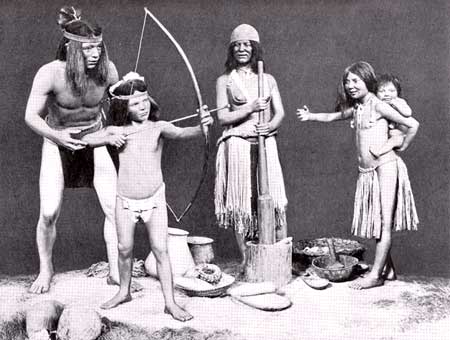
The Cocopa Indian family, shown in group 9, represents the Sonoran ethnic province. They occupy the lover valley of the Colorado River, Mexico, from the international boundary to the head of the Gulf of California. Although they were visited by Spaniards in 1540, and have been in contact with the Caucasian race for two hundred years, they retained their primitive traits up to about 1890. They subsist largely by means of agriculture, feeding partly on game and fish, with various seeds, roots, and fruits. They dwell in scattered settlements, usually of one to half a dozen houses, which pertain to a family or clan. Little costume is used, the men until recently habitually wearing skins and the women petticoats of the inner bark of willow, as seen in the illustration. Their faces are habitually painted, and they are tattooed moderately. The group includes five figures. A young man with bow and arrow is engaged in teaching a boy to shoot; the woman is pounding corn in a wooden mortar, and the young girl carries the babe and concerns herself with the how practice of the boy.
To the Next Group of Figures
Back to Smithsonian Report "The Department of Anthropology"
Back to the Smithsonian Institution/National Museum Exhibit
Back to U.S. Government Building Menu